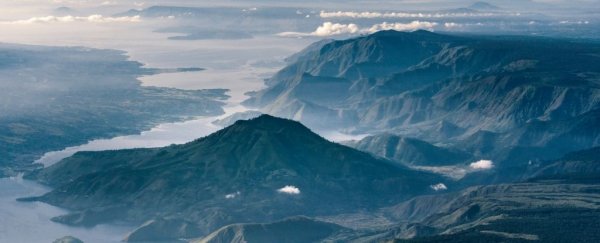Supervolcano eruptions have caused some of the greatest catastrophes in the history of our planet, and yet we still don't really know how to predict when or how they will strike.
Instead of slipping into a quiet recovery period, new research suggests some of these large volcanoes can remain active for thousands of years after their initial eruption, posing a threat for much longer than we thought.
Sometimes, the supervolcano might even go 'quiet' for thousands of years before briefly acting out again. These later eruptions are much tinier than the initial explosion, but they still represent a hazard.
"While a super-eruption can be regionally and globally impactful and recovery may take decades or even centuries," says volcanologist Martin Danišík from Curtin University in Australia, "our results show the hazard is not over with the super-eruption and the threat of further hazards exists for many thousands of years after."
The findings are based on models of the Toba super-eruption, which occurred nearly 75,000 years ago at what is now known as Lake Toba in Sumatra, Indonesia. What's left there today is a complex caldera with a smattering of domes and other features, most notably the Youngest Toba Tuff, which represents the last major eruption at the site.
At the time, this supervolcano blew approximately 2,800 km3 of hot magma into the air - one of the largest eruptions known to date. Some scientists think the explosion was so massive, it actually triggered a decade-long 'volcanic winter' and a glacial period that may have lasted a thousand years, although the details of the fallout are still hotly disputed.
Now, it seems the volcano's recovery phase, known technically as resurgence, is also under contention. The quiet period that comes after a supervolcanic eruption may not be so quiet after all.
"The findings challenge existing knowledge and studying of eruptions, which normally involves looking for liquid magma under a volcano to assess future hazard," explains Danišík.
But the liquid magma underneath Toba appears not to have stuck around for long after the initial eruption. Instead, as the floor of the caldera cooled, it squeezed the remnant magma up and out along fault lines, with a 'carapace' on top that Danišík likens to a turtle shell.
The finding is based on two proxies – the minerals feldspar and zircon – that hold a timestamp for volcanic gases, like argon and helium. These proxies were measured from samples of volcanic rock taken in the Toba caldera, to see if its dormant period resulted in any eruptions.
When researchers used the resulting geochronological data and plugged it into thermal modeling, they found multiple bouts of feldspar and zircon, and these eruptions were separated by around 13.6 thousand years.
Ultimately, the models suggest that a dome in the north of the caldera erupted around 4,600 thousand years after the initial, colossal eruption, whereas the Tuk Tuk dome towards the center erupted after an 8,000-year delay, and a dome in the south erupted after a 13,000-year delay.
All of these later eruptions appear to have "tapped the 'cold halo'" of the original Toba magma system during its dormant period.
"Our work thus demonstrates a significant delay between the Youngest Toba Tuff eruption and eruption of these domes," the authors write.
"We propose that eruptions of the domes signal the onset of resurgent uplift and associated opening of pathways to the surface through which remnant solidified conduit plugs and dikes were extruded to the surface by invading magma acting like the plunger in a syringe."
Even though these domes held cooled magma for thousands of years, the material was not so cool as to withstand eruption.
The magma wasn't re-heated by lava underneath, but instead it probably shot up into the air in a subsolid state. In light of the findings, the authors argue we need to reevaluate our concept of what is actually 'eruptible'.
The remnant magma after the initial Toba eruption was probably "coarsely crystalline mush that was barely mobile and non-eruptible", the authors say.
Yet once it made its way into the domes, it seems to have become eruptible again. More research is needed to figure out what exactly triggered this volatility and whether something similar could happen to other supervolcanoes on our planet, like Yellowstone.
Given how little we know of supervolcanoes in general, the suggestion that the Toba supervolcano continued to belch smaller bouts of magma in its resurgence period will no doubt continue to be discussed for years to come.
There might be rest for volcanoes, but not for volcanologists.
"Learning how supervolcanoes work is important for understanding the future threat of an inevitable super-eruption, which happen about once every 17,000 years," says Danišík.
"Gaining an understanding of those lengthy dormant periods will determine what we look for in young active supervolcanoes to help us predict future eruptions."
The study was published in Communications Earth & Environment.
